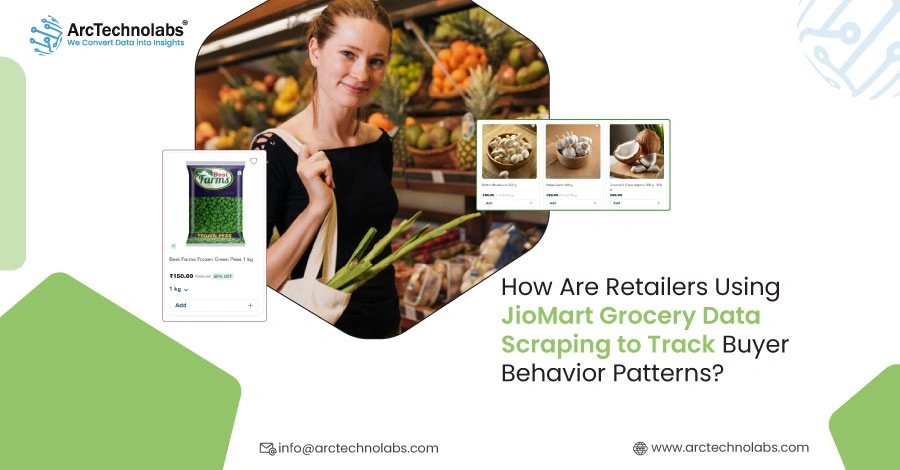
Introduction
Understanding consumer shopping behavior is at the heart of building impactful retail strategies. As grocery shopping in India rapidly moves online, platforms like JioMart are becoming valuable sources of behavioral insights. For innovative retailers, tapping into these data points using JioMart Grocery Data Scraping is reshaping how decisions are made.
Retailers now use Grocery E-Commerce Data Extraction and advanced scraping techniques to uncover key buyer behavior patterns, pricing shifts, product demand, and performance signals. By analyzing interactions on platforms like JioMart, they refine pricing strategies, streamline assortments, and manage inventory more efficiently through real-time, data-driven decisions.
This evolving approach is redefining modern retail intelligence, making it an essential asset for today’s strategic retail decision-making.
Understanding Buyer Intent Through Scraping Patterns
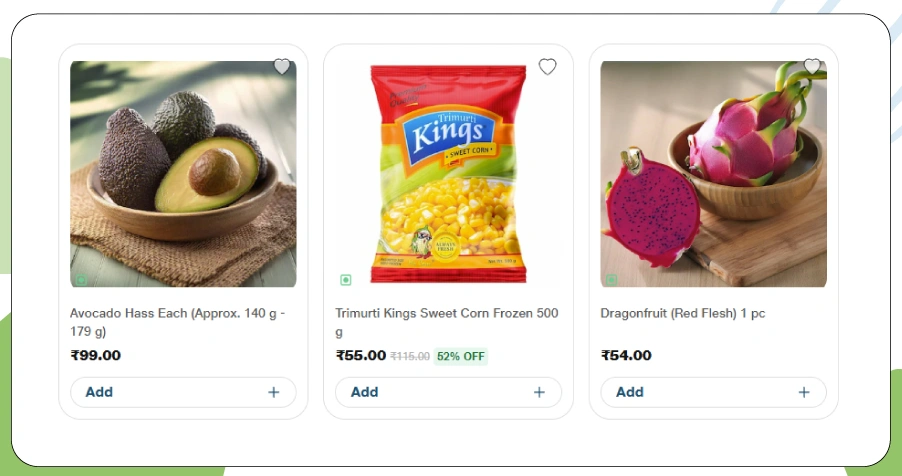
Retailers today are moving beyond traditional post-purchase analytics to uncover intent signals earlier in the customer journey. The real value now lies in pre-purchase actions—what users search, explore, abandon, or revisit—offering a more nuanced understanding of buying behavior.
By leveraging JioMart Grocery Data Scraping, businesses can decode these digital footprints to align better with actual consumer demand. This approach allows companies to turn browsing behavior into actionable demand signals by analyzing:
- Product Page Engagement Frequency: Tracking how often users visit specific product pages and identifying patterns in repeated visits before a purchase decision, revealing buyer hesitation or comparison behavior.
- User Interaction with Offers and Promotions: Analyzing how frequently shoppers engage with coupons, promotional banners, and discount tags helps identify which deals truly influence purchase decisions.
- Brand Preference Shifts: Observing shifts in user interest between regional and national grocery brands offers valuable insight into evolving brand loyalties and local market inclinations.
- Time-Based Shopping Patterns: Comparing weekday versus weekend traffic on core grocery items reveals time-sensitive shopping trends and helps optimize inventory planning and marketing campaigns accordingly.
Retailers utilize JioMart grocery data to align campaigns, promotions, and marketing efforts with actual consumer behavior and intent. This level of personalization, powered by Web Scraping For FMCG Insights, drives higher engagement and improved ROI.
Analyzing Category-Wise Purchase Behavior with JioMart Grocery Data
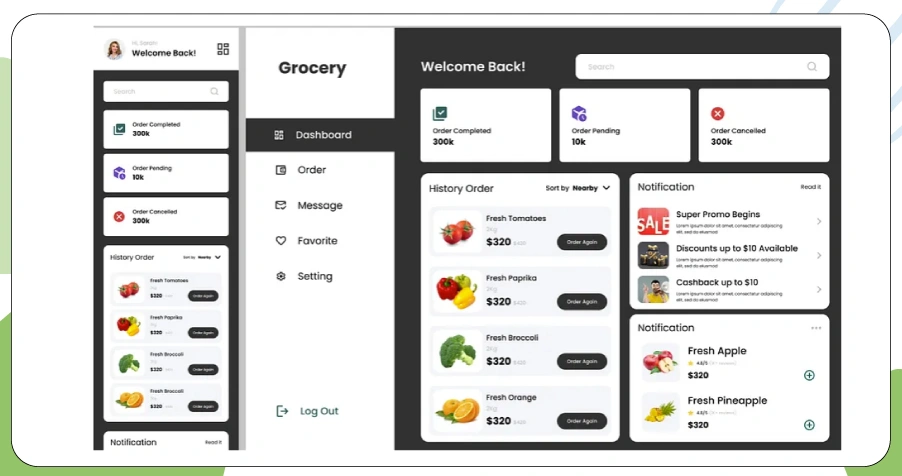
Retailers aiming to refine their category strategies often rely on JioMart SKU Analysis Scraping to dive deeper into product-level purchase behavior. By continuously tracking how different grocery segments perform, brands gain data-backed clarity into evolving consumer habits, identifying which products are trending, which are seasonal, and which are losing traction.
Here are a few critical insights derived through detailed analysis:
- Daily vs. bulk purchasing trends in household staples
Understand whether consumers prefer to purchase essential items like cleaning supplies, cooking oils, or grains in smaller daily quantities or larger bulk formats, offering clues into convenience versus value-driven buying behaviors.
- Seasonal spikes in demand for fresh produce and packaged snacks
Analyze how seasonal factors, festivals, or climate changes impact the purchase volume of perishable items and snack foods, helping teams prepare better for stocking and promotion schedules.
- Brand-switching behavior during promotional campaigns
Detects when and why customers shift from preferred brands to new or discounted ones, especially during limited-time deals, providing actionable insight into price sensitivity and promotional effectiveness.
These detailed behavior trends are integral to JioMart Purchase Behavior Analysis, enabling both brand marketers and category managers to stay closely aligned with real-time shifts in customer preferences and optimize their decisions accordingly.
Pricing Intelligence: How Retailers Align Grocery Value with Demand?
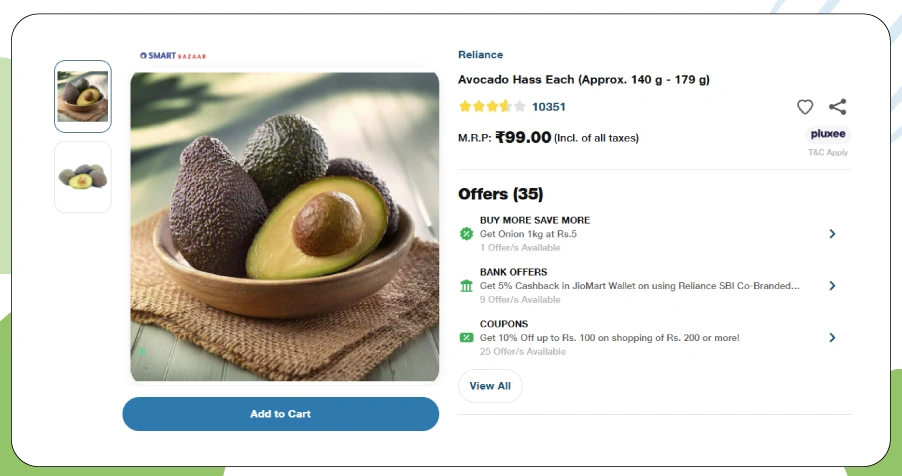
In today’s dynamic grocery retail landscape, staying ahead requires more than just competitive pricing—it demands Pricing Intelligence rooted in real-time insights. Retailers now turn to advanced methods to Analyze Grocery Prices on JioMart, enabling them to decode how pricing decisions shape buyer behavior patterns.
Scraped data helps retailers go beyond static pricing. By continuously tracking JioMart listings, they understand how price shifts impact conversions, shopping cart size, and overall consumer responsiveness. Whether it’s a flash discount or a bundled deal, these changes generate instant behavioral feedback. With updated datasets, brands can revise their pricing strategies as often as the market demands.
This high-frequency approach is crucial for responding to:
- Competitor Price Changes: Monitoring rival pricing on JioMart in near real-time allows businesses to adjust their product prices and avoid losing shoppers to better deals.
- Supplier Cost Fluctuations: As input costs rise or fall, pricing models can be recalibrated to maintain profitability while staying attractive to consumers.
- Real-Time Market Demand: Demand spikes—whether due to seasonal trends or regional events—can trigger price adjustments that help maximize revenue without losing volume.
These practices are deeply informed by JioMart Pricing Trends 2025, giving retailers predictive power to anticipate shifts and recalibrate strategies with greater precision. As a result, pricing decisions are no longer reactive—they’re data-led, deliberate, and aligned with real-time buyer behavior.
Smarter Inventory Management Through Real-Time Grocery Insights
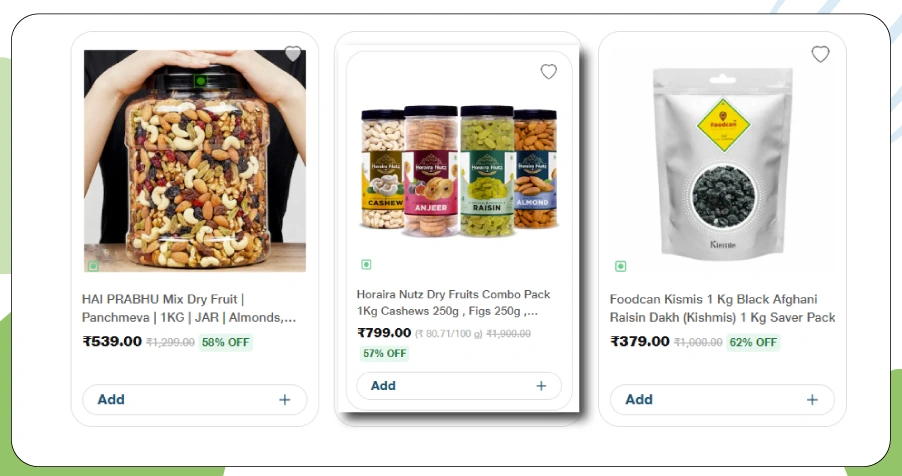
Retailers today are transforming how they manage shelf space by making stocking decisions based on real-time buyer behavior signals. With Real-Time Grocery Inventory Monitoring, businesses can align inventory flow with actual demand patterns, reducing wastage and improving fulfillment accuracy.
In fast-paced retail and quick commerce environments, precision is everything. By consistently using tools to Extract Grocery Product Data JioMart, platforms can respond faster to shifting consumer preferences.
Here’s how this data-driven approach impacts operations:
- Ensure in-demand items remain available: Real-time tracking ensures popular grocery products remain available across hyperlocal zones, helping retailers maintain customer satisfaction and avoid revenue loss.
- Enable hyperlocal forecasting: Access to up-to-date inventory and buyer data improves micro-market predictions, enabling stores to tailor inventory at the local level.
- Optimize logistics and replenishment cycles: Accurate demand signals streamline restocking schedules and quantities, minimizing warehousing overhead and last-mile inefficiencies.
This inventory intelligence becomes more effective when paired with Retail Customer Behavior Analytics, creating a closed feedback loop. Retailers can now align supply chain models directly with evolving consumer demand, leading to more responsive, profitable, and efficient operations.
Decoding Consumer Patterns Through JioMart Shopping Trends Data
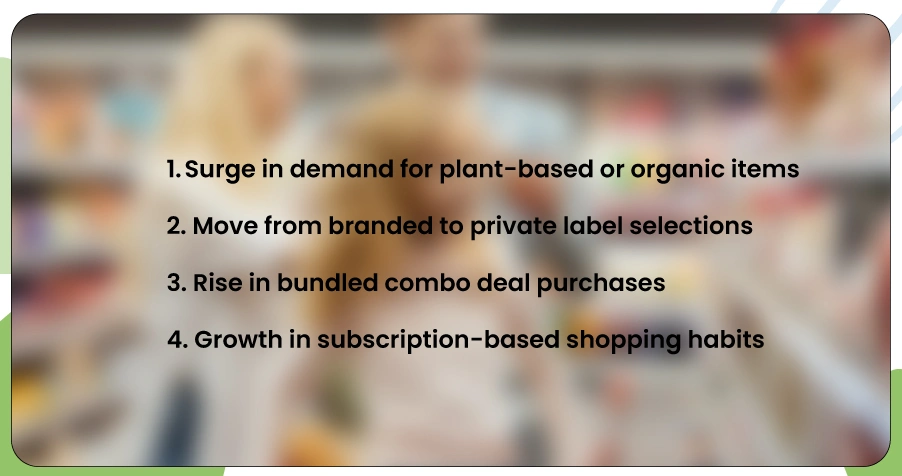
Retailers today must operate with agility in a landscape shaped by rapidly changing consumer behavior. Preferences are continuously shaped by evolving economic conditions, digital influence, shifting lifestyles, and seasonal or cultural factors. In this context, analyzing JioMart Shopping Trends Data becomes more than a competitive advantage—it’s a strategic imperative.
Using advanced scraping tools, businesses can track emerging and fading patterns in consumer activity across grocery categories. These behavioral cues can be translated into actionable Consumer Insights From Grocery Datasets, supporting everything from demand forecasting to assortment planning.
Key trend signals that can be extracted include:
- Surge in demand for plant-based or organic items: This reflects increasing health consciousness and sustainability awareness, signaling a shift toward cleaner ingredient preferences.
- Move from branded to private label selections: Budget-sensitive consumers may begin favoring in-house brands, offering retailers opportunities to boost margins while meeting value-driven expectations.
- Rise in bundled combo deal purchases: This suggests consumers are seeking cost-efficiency and convenience, insights that can drive promotional structuring and inventory bundling.
- Growth in subscription-based shopping habits: Recurring purchase behavior for essentials indicates an appetite for consistency and convenience, helping brands shape loyalty programs and fulfillment strategies.
When such behavioral trends are extracted and analyzed from Consumer Insights From Grocery Datasets, they empower businesses to make forward-thinking decisions on product innovation, targeted promotions, personalized offers, and even localized assortment curation based on regional buying patterns.
Retail Intelligence Driving India’s Modern Grocery Strategies
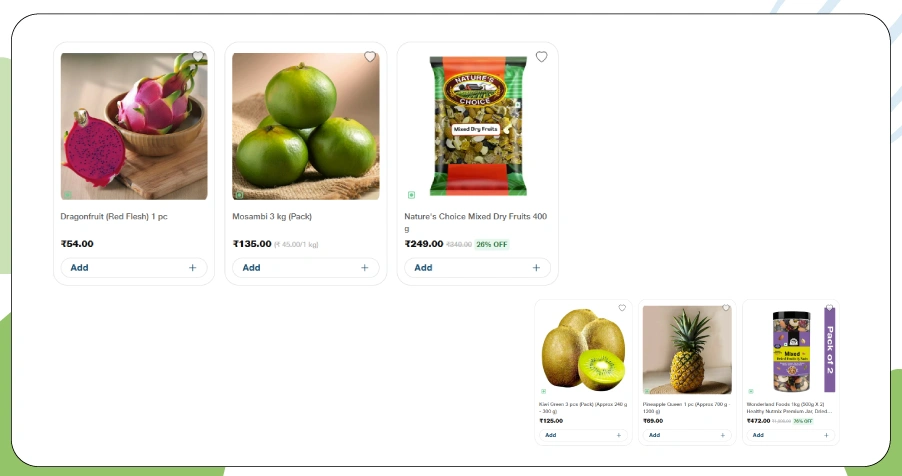
India’s digital-first grocery market is undergoing a significant transformation, driven by the growing adoption of intelligent data tools across the value chain. As highlighted in Grocery Scraping Trends India 2025, modern retailers are increasingly relying on data-driven strategies to enhance visibility, improve accuracy, and strengthen consumer engagement.
Here’s how grocery retailers are adapting and scaling operations by extracting actionable intelligence from consumer behavior datasets:
- Custom dashboards are enabling retailers to filter, tag, and compare key metrics across diverse SKUs, allowing for faster responses to shifts in consumer demand and inventory movement at a granular level.
- Predictive modeling based on historical purchase behavior is helping businesses anticipate future buying patterns, making demand forecasting smarter and more aligned with local and seasonal trends.
- Integration with marketing automation tools is becoming seamless, allowing businesses to run highly personalized, data-informed campaigns that align with customer preferences and behavior triggers.
At the core of this transformation is the Grocery Purchase Pattern Dataset, which empowers organizations to map user journeys with actionable business outcomes. When paired with the Online Grocery Dataset India, it unlocks a full-spectrum view of consumer activity and micro-market shifts, offering a critical advantage in an increasingly competitive landscape.
These data-driven insights lead to:
- Improved performance of promotional campaigns through precise targeting.
- Significantly reduced inventory waste with optimized stock management.
- Increased marketing ROI by aligning offers with buyer intent.
- Stronger customer retention due to personalized and relevant shopping experiences.
In an era of dynamic consumer expectations, these innovations aren't just trends—they're fast becoming the new standard in modern grocery retail.
How ArcTechnolabs Can Help You?
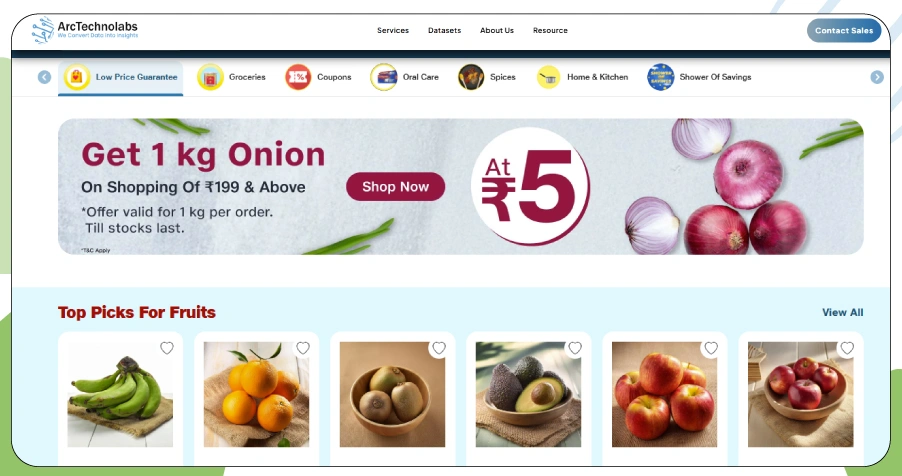
We offer tailored solutions built around JioMart Grocery Data Scraping to help retailers capture buyer behavior in real time. Whether you're focused on tracking SKU-level trends, optimizing pricing, or enhancing customer targeting, our systems are designed to turn raw grocery data into intelligent business actions.
Here’s what we deliver to help you move faster and smarter in your retail decisions:
- Custom pipelines are built for specific categories or geographies.
- Real-time dashboards that highlight product and consumer trends.
- SKU-level data tracking for availability and pricing updates.
- Seamless data exports for your BI or analytics tools.
- High-frequency scraping with compliance safeguards.
- Quick onboarding with flexible solution design.
By combining deep domain knowledge with automation tools, you gain a sharper edge in Consumer Insights From Grocery Datasets, driving more brilliant business moves across every retail function.
Conclusion
Retailers today are embracing JioMart Grocery Data Scraping to decode fast-changing consumer preferences and stay competitive in the digital grocery space. By tapping into these insights, they make faster, data-backed decisions on pricing, product placement, and promotions.
With accurate Retail Customer Behavior Analytics, businesses can transform scattered buyer activity into meaningful strategies. Ready to move from guesswork to precision? Contact ArcTechnolabs today to build a data-driven retail roadmap tailored to your goals.







